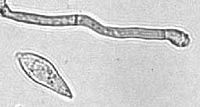
Photo from wikipedia
Plant growth-promoting rhizobacteria (PGPR) are known to stimulate plant growth because of their versatility in nutrient transformation. However, the success of PGPR inoculation depends not only on their ability to… Click to show full abstract
Plant growth-promoting rhizobacteria (PGPR) are known to stimulate plant growth because of their versatility in nutrient transformation. However, the success of PGPR inoculation depends not only on their ability to promote plant growth but also on their capacity to metabolize substrates that can be used as energy for the development and survival of the crops. Given the important influence of seed germination and vigor on crop yield, this study investigated the biochemical characteristics and effectiveness of multi-trait PGPR isolates in enhancing upland rice seedling growth and vigor. Biochemical identification was done using Biolog GEN III Microbial Identification System. Isolates were characterized based on their ability to metabolize all major classes of biochemicals in the carbon source utilization and chemical sensitivity assays. Identified rhizobacterial isolates were tested in vitro to evaluate their inoculation effects on the growth of PSB Rc23 upland rice seedlings. Biochemical identification results showed that rhizobacterial isolates have extensive metabolic activities in a wide range of carbon sources. Inoculation effects revealed that isolate IBBw1a was the most effective in enhancing root length and vigor index of rice seedlings in vitro, yielding a significant increase of 60% and 53%, respectively, over the uninoculated control. This study suggests that rhizobacterial isolates from upland rice may have commercial significance to improve seedling growth and vigor. These isolates will undergo a further assessment of their effectiveness in actual upland rice field conditions as they were already proven effective growth promoters in laboratory and screenhouse conditions. Such future activity can uncover their efficacy as potential biofertilizers in the actual soil environment.
Journal Title: Archives of microbiology
Year Published: 2021
Link to full text (if available)
Share on Social Media: Sign Up to like & get
recommendations!